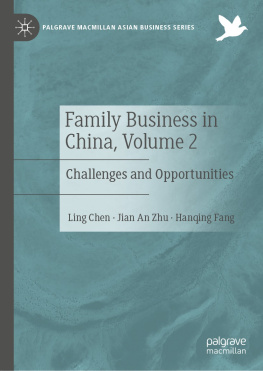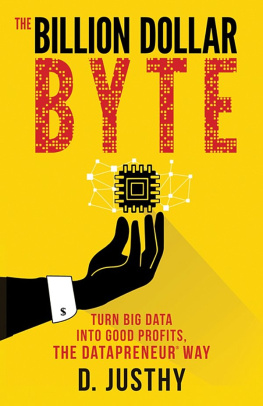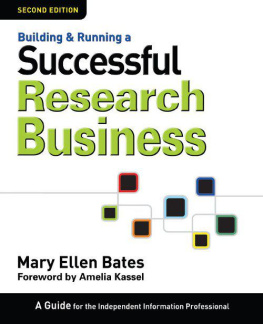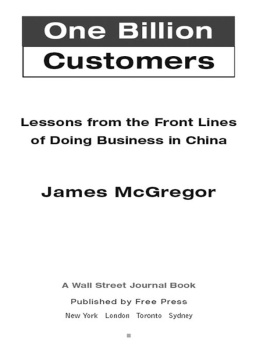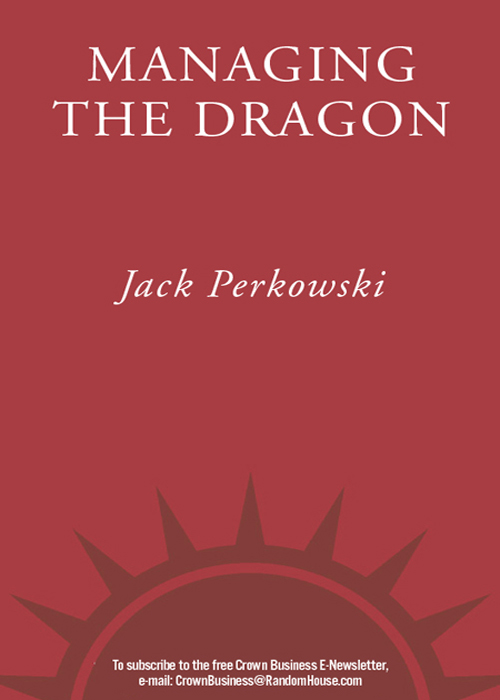
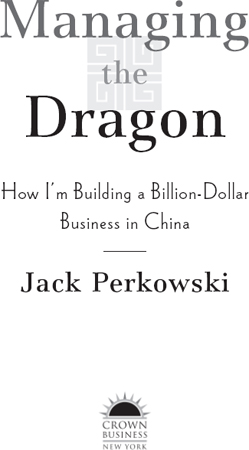
Contents
TO MY MOTHER, ADELE,
AND IN MEMORY OF MY FATHER, JOHN.
They instilled in me the values of hard work and
determination, and their emphasis on the importance of
education was a strong and constant influence.
Whether I was in Pittsburgh, New Haven, Boston,
New York, or Beijing, they provided unspoken support and
a strong anchor to windward.
Introduction
She thinks my tractors sexy
It really turns her on
Shes always starin at me
While Im chuggin along
She Thinks My Tractors Sexy, KENNY CHESNEY
I t was a warm, clear, starlit night in Tucson in April of 2006. I was sitting in the bleachers at Caterpillars Arizona proving grounds, along with five hundred executives from the company and its key suppliers, listening to Kenny Chesney tout the merits of his tractor as an aphrodisiac and watching expert operators put a dozen CAT machines through their paces.
As the music blared and synchronized multicolored spotlights flashed, a pair of massive dump trucksthe kind used to haul coal from large mines in Australiarumbled down the hill in the far background, disappeared into the valley below, and then suddenly reappeared to our right and sped past the stands, throwing up clouds of dust in their wake. The music was so loud that it drowned out the roar of their engines. Meanwhile, giant earthmovers pushed tons of dirt into the waiting buckets of enormous CAT loaders, the kind with rubber tires more than twice a mans height. And then, suddenly, the hillside in front of us erupted with lights and movement, as three smaller earthmovers popped out of hidden tunnels that had been burrowed into the bank.
It was about as impressive an equipment show as I have ever seen, or could ever hope to see, and I doubt Ill ever see anything like it again. I couldve sat there watching and listening all night.
On that evening in Tucson, we were a long way from Chinabut China was on everybodys mind. Caterpillar had gathered us there, in the first-ever meeting of its 150 or so strategic suppliers, to roll out its Vision 2020, a strategy to become a $100 billion company by the year 2020. At the meetings during the day, CAT executives described the companys seven key success factors. Three could be found at most companies: people, products, and quality. Three were unique to Caterpillar: distribution, ability to be profitable through a trough, and velocity, or speed to market. The most interesting factor, though, was the seventh: China. Over the course of three days in Tucson, every senior CAT executive, from CEO Jim Owens on down, stood in front of the companys key suppliers and said that CAT had to be number one in China by 2020. If it wasnt, the companys position as the global leader in its industry would be in question.
It was a stunning announcement. Caterpillar, one of the most successful industrial companies in the world, was saying that its future viability as a global leader depended on how it did in China. CAT is a proud company, almost one hundred years old, and it has survived severe threats to its position before. In the late 1980s and early 1990s, CAT successfully withstood strong competition from Komatsu, its formidable Japanese competitor, while also finding a way to come to terms with its unionsthereby avoiding the legacy issues that now threaten the U.S. automakers. Renewed spending for natural resources exploration and mining, in the wake of sharp increases in the prices of raw materials that began shortly after the turn of the century, had pushed the company even further into the black, and the company was having its best years ever.
But here CAT was, at the top of its game in the spring of 2006, saying that the future was in China. A lot of companies have set their sights on China. But, to my knowledge, CAT was the first major company to draw such a clear line in the sand regarding Chinas importance to its future success.
The fact that the largest, most successful companies in the world are coming to the same conclusion as Caterpillar is testimony to how far China has come in the last ten years. There will be bumps in the road, and Chinas growth as an economy wont flow smoothly from the bottom-left to the upper-right side of the chart. But the fact remains that China will be the biggest, fastest-growing economy in the world in the twenty-first century. Any company that doesnt do what CAT has done, to make becoming a leader in China an irrevocable priority, may be relegating itself to a future as a second-rate player.
What makes Chinas continued development so scary, to companies and individuals alike, is that its happening so fast. Like a large rock rolling down the side of a mountain, Chinas economy is gathering momentum and gaining speed. After a period of double-digit growth in the post-Tiananmen period of the early 1990s, the law of large numbers would have predicted that that kind of growth couldnt happen again. But China has defied conventional wisdom. Already one of the worlds largest economies, China grew by at least 10 percent in 2003, 2004, 2005, 2006, and 2007. The country had $21 billion in foreign reserves in 1993; ten years later, in 2003, China was adding $200 billion or more of reserves into its coffers each year. By the end of 2006, China had more than $1 trillion in foreign currency reserves, an unprecedented amount that was growing by $50 billion each month. The entire world is watching to see what the country does with its cash hoard.
The accelerated pace of Chinas economic development has us all riding on the back of a tiger, as the Chinese would say. Its dangerous, perhaps fatal, to try to jump off, but its also exceedingly difficult to stay on unless you know what you are doing.
What do individuals and companies of all sizes need to know to be successful in China? Everybody has their own opinion, but if I had to boil down everything Im going to tell you in this book into one important idea, its this: you have to develop a strong local management team for your company here. Theres no way around it. After operating in China for fifteen years, Ive seen companies come and go, but those that develop good local Chinese management teams that understand the companys goals and can respond to the unique elements of the Chinese environment are those that stand the best chance of success. We tried several different ways to close Chinas management gapand Ill walk you through all of thembefore we finally arrived at the approach that ultimately saved our company. That story lies at the heart of this book.
On a broader level, I also hope to tell you a bit more about where China is today, from the perspective of practical experience, not theory or hypothesis. Most people assume that China is a bureaucratic monolith, ruled from on high in Beijing. Right off the bat, its important to understand that this couldnt be further from the truth. China has historically been, and still is, highly decentralized. Edicts from Beijing dont necessarily carry the same weight that one might think. Chinas decentralization, as Ill discuss later, is part of the dynamic that causes the country to create overcapacity for every product. It also leads to extremely fragmented industries, which are only becoming more soand not consolidating, as conventional wisdom would have it.
Despite its shiny facade, China is in a different place economically than the rest of the developed world. From the outside, the country appears to be modern, rich, and prosperous, the epitome of the rich new kid on the block with all of the trappings and swagger that go with that status. Underneath that image, though, lies a soft underbelly of incredible poverty for the vast majority of the countrys population. Isolated from the rest of the world from 1949 to 1978, China underwent a thirty-year time warp that continues to affect the country in all kinds of ways. As a result, the cost perspective here is more similar to the United States of the 1950s than it is to the United States of today, a fact that permeates all aspects of the Chinese economy.
Next page


